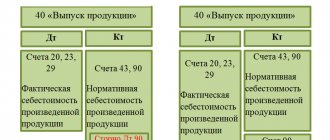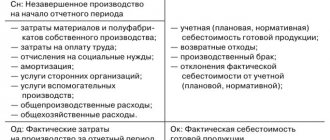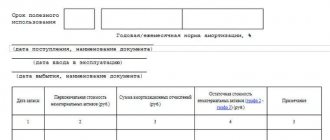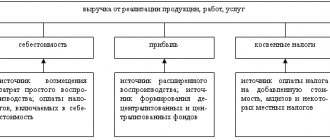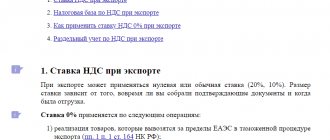Main elements of expenses for ordinary activities
Pay attention to the table of expenses for ordinary activities.
| What does the organization do? | What expenses are considered for ordinary activities? |
| Providing for a fee for temporary use (temporary possession and use) of one’s assets under a lease agreement | The implementation of which is related to this activity |
| Providing for a fee rights arising from patents for inventions, industrial designs and other types of intellectual property | |
| Participation in the authorized capital of other organizations |
If the expenses listed in the table are not the subject of the organization’s activities, then they are classified as other expenses.
Also see “What Other Expenses Include in Accounting.”
Also for ordinary activities there are expenses in the form of reimbursement of the cost of fixed assets, intangible assets and other depreciable assets, in the form of depreciation charges.
Income from ordinary activities
The rules for recording income in the accounting of Russian organizations are enshrined in PBU 9/99. The accounting regulations were approved by Order No. 32n dated 05/06/99. It instructs companies to recognize receipts as income from ordinary activities or classify them as other transfers. In this case, income from ordinary activities of the organization is recognized as receipts for products or payment for services rendered.
Features of revenue recognition for organizations of different types of activities
If a company is engaged in renting out objects, including leasing, its revenue will be rent or leasing payment. For organizations whose business is based on participation in authorized capital or the provision of rights for a fee, income from ordinary activities includes revenue from these activities.
Rules for assessing revenue for accrual purposes
Revenue is reflected in the accounting accounts as follows:
- in the amount of total receipts for goods shipped, work performed
- in the amount of receipts and receivables in case of partial payment
- in the amount of receivables when a deferred payment is given to the customer
- according to the value of values transferred in exchange for goods and works
If agreements have changed and amendments have been made to the price of products or work under a previously concluded contract, the original amount of revenue must also be adjusted. Income from other types of activities is accounted for in the same way, but on other accounting accounts, in accordance with the instructions to the chart of accounts and PBU “Income of the organization.”
Example
The settlement account of an organization engaged in the sale of plumbing fixtures received proceeds from a contract for the sale of a batch of toilets in the amount of 250,000 rubles, and the cash desk received a fee for renting out a utility room next to the warehouse in the amount of 18,000 rubles.
Since wholesale and retail trade is the main activity of the company, the amount of 250 thousand rubles. will be reflected by the wiring:
Debit 51 “Current account” Credit 90 “Revenue”.
Renting is classified as other operations and is not classified as the main activity of the company, so the income is 18 thousand rubles. The accountant will write it like this:
Debit 50 “Cash” Credit 91.1 “Other income”.
Accounting for expenses for ordinary activities
The expenses in question are accepted for accounting in a monetary amount equal to the payment:
- in cash and other forms;
- the amount of accounts payable (taking into account clause 3 of PBU 10/99).
If payment covers only part of the recognized expenses, then the expenses taken into account are the sum of payment and accounts payable (in the part not covered by payment).
The amount of payment and/or accounts payable is determined based on the price and conditions established by the agreement between the organization and the supplier (contractor) or other counterparty.
If the price is not provided for in the contract and cannot be established based on its terms, to determine the amount of payment or accounts payable, the price at which, in comparable circumstances, the organization usually determines expenses in relation to:
- similar inventories and other valuables, works, services;
- provision of temporary use (temporary possession and use) of similar assets.
When paying for purchased materials and other valuables, works, services on the terms of a commercial loan in the form of deferred/installment payment, expenses are taken into account in the full amount of accounts payable.
Also see “Accounting for inventories”.
The amount of payment and/or accounts payable under contracts providing for the fulfillment of obligations (payment) not in money is determined by the cost of goods (valuables) transferred or to be transferred by the organization - based on the price at which, in comparable circumstances, the company usually determines the cost of similar goods (valuables) .
If it is impossible to establish the cost of goods (valuables) transferred or to be transferred by the organization, the amount of payment and/or accounts payable under agreements providing for non-monetary settlement is determined by the cost of products (goods) received by the organization - based on the price at which a similar product is purchased in comparable circumstances products (goods).
Peculiarities:
- in the event of a change in the obligation under the contract, the initial amount of payment and/or accounts payable is adjusted based on the value of the asset to be disposed of - based on the price at which, in comparable circumstances, the organization usually determines the value of similar assets;
- the amount of payment and/or accounts payable is determined taking into account all discounts (discounts) provided to the organization in accordance with the agreement.
Also see “What is the statute of limitations for accounts payable.”
Rules for grouping expenses by ordinary activities
Further formation of expenses for ordinary activities goes towards:
- expenses associated with the acquisition of raw materials, materials, goods and other materials;
- expenses arising directly in the process of processing (refinement) of inventories for the purposes of producing products/performing work/providing services and their sale, as well as the sale (resale) of goods (costs of maintaining and operating fixed assets and other non-current assets, as well as maintaining them in in good condition, commercial expenses, administrative expenses, etc.).
When generating expenses for ordinary activities, it is necessary to group them into the following elements:
- material costs;
- labor costs;
- contributions for social needs;
- depreciation;
- other costs.
For management purposes, accounting organizes the accounting of expenses by cost items. The organization establishes their list independently.
RUSSIAN RULES FOR CLASSIFICATION OF COSTS.
Accounting for expenses is regulated by PBU 10/99 “Expenses of the organization.” According to paragraph 4 of PBU 10/99, the expenses of an enterprise, depending on their nature, conditions of implementation and areas of activity, are divided into two types:
- expenses for ordinary activities;
- other expenses.
Expenses for ordinary activities are expenses associated with the manufacture of products and the sale of products, the acquisition and sale of goods. These expenses also include expenses the implementation of which is associated with the performance of work and the provision of services. Expenses for ordinary activities also include reimbursement of the cost of fixed assets, intangible assets and other depreciable assets, carried out in the form of depreciation charges.
Clause 8 of PBU 10/99 defines the grouping of expenses for ordinary activities according to the following elements:
- material costs;
- labor costs;
- contributions for social needs;
- depreciation;
- other costs.
Other expenses are considered expenses other than expenses for ordinary activities. Other expenses include expenses the implementation of which is associated with the provision for a fee for temporary use (temporary possession and use) of one’s assets, rights arising from patents for inventions, industrial designs and other types of intellectual property, and from participation in the authorized capital of other organizations, when this is not the subject of the enterprise’s activities[1].
Other expenses are considered:
- expenses associated with the provision for a fee for temporary use (temporary possession and use) of enterprise assets;
- costs associated with the provision for a fee of rights arising from patents for inventions, industrial designs and other types of intellectual property;
- expenses associated with participation in the authorized capitals of other organizations;
- expenses associated with the sale, disposal and other write-off of fixed assets and other assets other than cash (except foreign currency), goods, products;
- interest paid by an enterprise for the provision of funds (credits, borrowings) to it for use;
- expenses related to payment for services provided by credit institutions;
- contributions to valuation reserves created in accordance with accounting rules (reserves for doubtful debts, for depreciation of investments in securities, etc.), as well as reserves created in connection with the recognition of contingent facts of economic activity;
- fines, penalties, penalties for violation of contract terms;
- compensation for losses caused by the enterprise;
- losses of previous years recognized in the reporting year;
- amounts of receivables for which the statute of limitations has expired, and other debts that are unrealistic for collection;
- exchange differences;
- the amount of asset depreciation;
- transfer of funds (contributions, payments, etc.) related to charitable activities, expenses for sporting events, recreation, entertainment, cultural and educational events and other similar events;
- other expenses.
Other expenses are also expenses that arise as a consequence of emergency circumstances of economic activity (natural disaster, fire, accident, nationalization of property, etc.).
Disclosing the procedure for recognizing expenses in the statement of financial results, the Ministry of Finance in paragraph 19 of PBU 10/99 indicates that this recognition is carried out taking into account the relationship between expenses incurred and revenues (that is, the correspondence of income and expenses must be ensured). As can be seen from the classification presented above, both the list of expenses for ordinary activities and the list of other expenses are open. All this together leads to this: when establishing a connection between expenses incurred and income, accountants are guided by professional judgment that “migration” of expenses from one type to another is possible and that there may be a difference of opinion on certain issues of classification of expenses. To illustrate, let's look at a couple of examples.
Are material costs, labor costs, contributions to insurance funds, and depreciation always considered expenses for ordinary activities? No, it is not always, for example, recommended to write off accrued depreciation on a non-production facility as a debit to account 91-2 “Other expenses”, because all “social services”, as not related to production activities, are written off as other expenses. Moreover, this practice operates despite the direct instruction in PBU 10/99 to classify depreciation charges as expenses for ordinary activities. Similarly, wages accrued to an employee whose activities are related to leasing property are written off to the debit of account 91‑2, because the rent is included in other income (to the credit of account 91‑1 “Other income”).
A selective analysis of the financial statements of unitary enterprises for 2021, which are in the public domain, showed that the breakdown of other expenses includes the following expenses (among those that could have been taken into account under other circumstances as expenses for ordinary activities) expenses:
- taxes from own funds;
- financial assistance and other payments to employees and pensioners.
Interim conclusion: such cost elements as labor costs, social contributions, depreciation, can be included in other expenses if this ensures compliance between income and expenses.
Next example. Budget funds in accordance with clause 8 of PBU 13/2000 are written off from the target financing account as an increase in financial results (on credit to account 91-1). At the same time, expenses for the financing of which a subsidy was provided are most often written off as expenses for ordinary activities (in the debit of accounts 20, 23, 25, 26...) on the basis, for example, that wages were paid to production workers, depreciation was accrued on production means. Formally, with this approach to accounting (in which the subsidy is reflected as part of other income, and subsidized expenses as part of the cost price), the connection between income and expenses is broken. However, this method of reflection, in which the nature of expenses prevails over the source of their coverage, is the most common. During a selective check of the financial statements of unitary enterprises for 2021, the author did not find that expenses financed by state aid were disclosed as part of other expenses. True, this does not mean that they are not there, since enterprises do not decipher all their expenses, and often the “Other” line occupies a significant share in the “Other expenses” section.
Subsequent analysis of expenses for ordinary activities
To form a financial result from ordinary activities, the cost of goods, products, works, and services sold is determined. It is formed on the basis of:
- expenses for ordinary activities recognized in the reporting year and in previous reporting periods;
- carryover expenses related to the receipt of income in subsequent reporting periods;
- adjustments depending on the characteristics of production and sales.
At the same time, selling and administrative expenses can be recognized in the cost of goods sold in full in the reporting year and recognized as expenses for ordinary activities.
The rules for accounting for the costs of production/sale of goods/performance of work/provision of services in the context of elements and items, cost calculations are established by separate regulations and Methodological Guidelines for Accounting (for example, if the MPZ is the order of the Ministry of Finance dated December 28, 2001 No. 119n).
Also see “How expenses are recognized in accounting.”
Read also
17.09.2019


